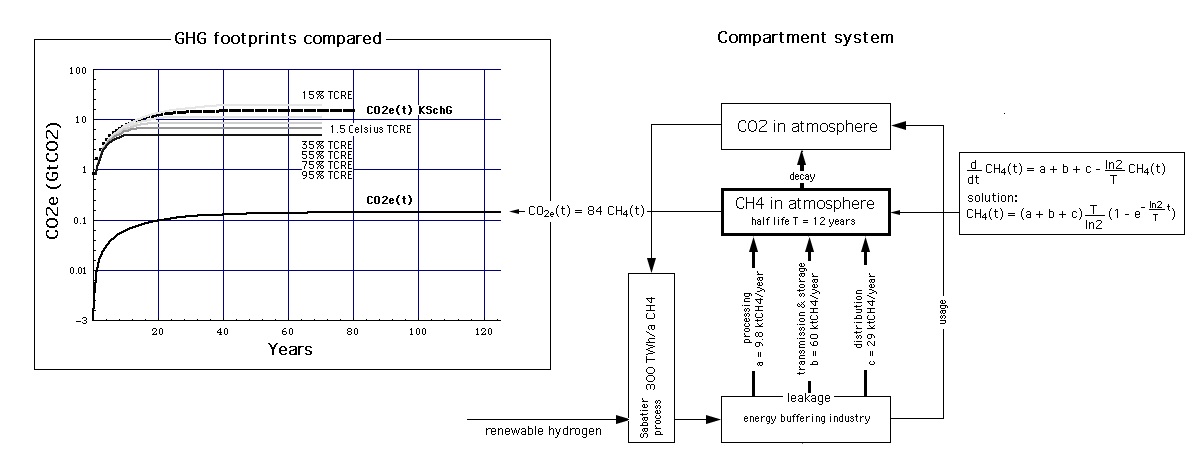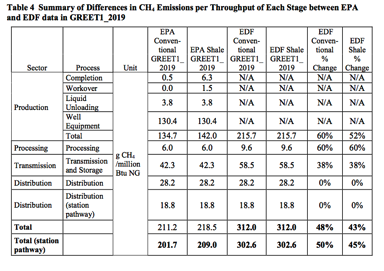Renewable Methane Leakage in Germany: Impact on Global Warming
Usage of 300 TWh/year of Renewable Methane to buffer Germany's fluctuating renewable electricity
by Joachim Gruber
Abstract
Renewable energies, even when combined, need a buffer of about 15 %. When methane is used to buffer German renewable electricity production, methane leaking into the atmosphere will build up a stationary methane pool within approximately 25 years. Then the pool will contribute a constant total of 0.14 GtCO2e to the German Greenhouse Gas (GHG) footprint, i.e. 1.75 tCO2e per person. For comparison: the present annual GHG emissions per German individual are about 10 tCO2e per year and person.

Fig. 1: Compartment system (center, with mathematical representation on the right) modeling the German Greenhouse Gas (GHG) footprint (insert on the left) of a 300 TWh/a renewable methane industry buffering the fluctuations of German renewable electricity generation.
The size of the industry (300 TWH/a) is taken from e.g. scenarios 2.1 and 2.2, Sachverständigenrat für Umweltfragen (SRU), Wege zur 100 % erneuerbaren Stromversorgung, Sondergutachten, Januar 2011 (for more see Appendix). The Sabatier process takes the carbon it needs from the atmosphere. Methane leaking into the atmosphere while it is processed (a), transmitted and stored (b) and distributed (c) decays into CO2 with a half life T = 12 years. This CO2 is then reused by the Sabatier process. Thus the carbon system is closed, meaning that carbon neither leaves the system nor enters into it. Leakage data a, b, c are taken from the Argonne Natl. Laboratory's GREET1_2019 model (see Tab. 4, below).
Shaded Insert
GHG footprints compared
- x-axis starts with year 2018 (x = 0 means year 2018).
- y-axis specifies the cumulative German GHG footprint in GtCO2 equivalents (GtCO2e).
- Dashed curve CO2e(t) KSchG: development of the cumulative total German GHG emissions after the Klimaschutzgesetz.
- Gray curves 1.5 Celsius TCRE: Germany's cumulative CO2 footprint meeting the 1.5 Celsius global warming limit calculated with the TCRE model (Fig. 2.3, page 105, Chapter 2, Mitigation Pathways Compatible with 1.5 Celsius in the Context of Sustainable Development, IPCC SR15). Disregarding historical responsibility (Option I, WBGU, 2009), this model is applied with the assumption that Germany's remaining CO2 budget as of 2018 is 1% of the remaining global CO2 budget (because its population is 1% of the global population). The gray curves represent the probabilities 15%, 35%, 55%, 75%, 95% (from top to bottom). As can be seen, the Klimaschutzgesetz (CO2e(t) KSchG) meets the 1.5 Celsius global warming limit with approximately 25% TCRE probability.
- Curve CO2e(t): To simplify the diagram it is assumed that the energy buffering industry starts up at time 0.
- A stationary methane pool builds up (in compartment CH4 in atmosphere) from CH4 leaking from the methane industry. The CH4 pool size is converted from GtCH4 to GtCO2e by multiplication with the CH4 warming potential, which is 84.
- The stationary pool size is 0.14 GtCO2e.
- This is 34 times less than the 95% probability limit (4.8 GtCO2e) given by the 1.5 Celsius TCRE model for Germany and disregarding the "historical responsibility".
- Evenly distributed over 80 million Germans 0.14 GtCO2e is 1.75 tCO2e/person.
- Note: The TCRE model is a plausible, yet simple fit to the CMIP5 Earth System Models of high complexity. Like those models it does not associate a fixed CO2 emission budget with a global warming limit (here 1.5 Celsius), but it rather gives CO2 emission budgets that meet the warming limit with given probabilities. (More on the limitations of the TCRE model on pages 102 - 104, Thematic Focus Elements TFE.8 "Climate Targets and Stabilizaion", Technical Summary, CLIMATE CHANGE 2013, The Physical Science Basis, IPCC)
I. Data for 300 TWh/year compartment model (above Figure)
|
leakage pathway
|
GREET1_2019 Tab. 4 leakage constant (gCH4/(106 Btu))
|
leakage constant
for 300 TWh/year system
(ktCH4/year)
|
|
processing
|
9.6
|
a = 9.83
|
|
transmission and storage
|
58.5
|
b = 60.0
|
|
distribution
|
28.2
|
c = 29.0
|
conversions used:
- 106 Btu = 2.93 10-7 TWh
- 1.02 1015 Btu = 300 TWh
II. Sources
II. 1 WORKING PAPER 2020-02
The climate implications of using LNG as a marine fuel
Authors:
Nikita Pavlenko, Bryan Comer, PhD, Yuanrong Zhou, Nigel Clark, PhD, Dan Rutherford, PhD
Table 5: Methane leakage assumptions per unit consumption of natural gas (1 GJ = 778 kWh)
[note added by J.G.
natural gas contains from 50 to 90 % methane (depending on the source)
1 GJ natural gas = 18.6 kg natural gas (https://www2.gov.bc.ca/assets/gov/taxes/sales-taxes/publications/conversion-factors-by-fuel.pdf) = approx. 18 kg CH4

For this analysis, we used the GREET (Greenhouse gases, Regulated Emissions, and Energy use in Transportation) model (Argonne National Laboratory, 2018) to estimate upstream emissions for LNG and conventional marine fuels. GREET provides a robust dataset of emissions related to fuel production and breaks them into various life-cycle phases; there is also the option to supplement with user data to assess the impact of various assumptions on a fuel's full well-to-wake (WtWa) GHG emissions. GREET is used widely by government agencies, industries, and academia because it is transparent, flexible, and contains high-quality data.
II. 2 GREET Argonne National Laboratory (ANL)
page 5, Table 4: Summary of Differences .... in A. Burnham, Updated Natural Gas Pathways in the GREET1_2019 Model, October 2019

Appendix
Projected Methane Production in Germany
Projected CH4 production and consumption in Germany is
- 80 ... 180 GW synth. Methan-Herstellung,
- 300 ... 1000 TWh/a
- Source: Tabelle 8 & 9 Zusätzlicher Strombedarf im Verkehrsbereich durch die Substitution der fossilen Energietrger ohne & mit Effizienzmanahmen, Volker Quaschning et al., Sektorkopplung durch die Energiewende - Anforderungen an den Ausbau erneuerbarer Energien zum Erreichen der Pariser Klimaschutzziele unter Bercksichtigung der Sektorkopplung, Volker Quaschning, Hochschule für Technik und Wirtschaft HTW Berlin, Fachbereich 1 Ingenieurwissenschaften Energie und Information, Forschungsgruppe Solarspeichersysteme
- 300 TWh/a
- Source: Tab. 3-6 (Seite 116) und 3-7 (Seite 122) in Sachverständigenrat für Umweltfragen (SRU), Wege zur 100 % erneuerbaren Stromversorgung, Sondergutachten, Januar 2011. Abbreviations: DE = Deutschland, DK = Dänemark, NO = Norwegen
- Szenario 2.1 (Tab. 3-6)
- Vollständige Selbstversorgung Deutschlands bezogen auf jährliche Produktion
- Austausch von max. 15 % der Jahresarbeit mit DK/NO möglich
- Nachfrage in DE 2050: 500 TWh/a
- Szenario 2.1.a: DE-DK-NO 100 % SV- 500. Strom-Glättungsbedarf = 76.4 TWh/a. Methanbedarf*) = 217 TWh/a
- Nachfrage in DE 2050: 700 TWh/a
- Szenario 2.1.b: DE-DK-NO 100 % SV- 700. Strom-Glättungsbedarf = 103.1 TWh/a. Methanbedarf*) = 294 TWh/a
- Szenario 2.2 (Tab. 3-7)
- Maximal 15 % Nettoimport aus DK/NO zulässig
- und Austausch von max. 15 % der Jahresarbeit
- Nachfrage in DE 2050: 500 TWh/a
- Szenario 2.2.a: DE-DK- NO 85 % SV-500. Strom-Glättungsbedarf = 76.4 TWh/a. Methanbedarf = 217 TWh/a
- Nachfrage in DE 2050: 700 TWh/a
- Szenario 2.2.b: DE-DK- NO 85 % SV-700. Strom-Glättungsbedarf = 105.0 TWh/a. Methanbedarf = 300 TWh/a
- *)Unlike the SRU-Sondergutachten we are here buffering the electric energy with the chain electrolysis (with electricity from renewables) --> methanation (Sabatier reaction) --> generation of electricity (predominantly in power plants). The efficiency of the chain is 35% (chapter 7.3, UBA). Therefore methane consumption (approx. 300 TWh/year) is higher by a factor of 3 than the electric energy buffer demand (approx. 100 TWh/a).
- 50 TWh
- In Deutschland vorhandene Erdgasspeicher kšnnen 2017 schon mehr als den kompletten deutschen Stromverbrauch von weit źber 1 Monat (ca. 50 TWh) puffern.
- Electricity storage for the energy transition, Volker Quaschning, 13. Januar 2017
(Zeit: 5:59) "Das Schšne an der Power-to-Gas-Lšsung ist, dass die Speicher, die wir brauchen, heute zum grš§ten Teil schon da sind." ... Beispiel:
- Gasspeicher Rehden, die grš§te deutsche Gasspeicheranlage:
- Speichervolumen = 4.4 109 m3 Gas.
- In Gaskraftwerken in Strom umgewandelt: 2 Wochen volle deutsche Stromversorgung (500 TWh/a / (52 Wochen/a) 2 Wochen = 20 TWh)]
- Wirkungsgrad Power-to-Gas: 35% - 50%. "Daher wird man diese Speicher saisonal nutzen, d.h. nur 1, 2, 3 Male pro Jahr einzetzen.
- Fźr hŠufigeren Einsatz braucht man Batterien. Das Schšne an Batterien ist, dass wir sie dezentral aufstellen kšnnen. ... Wenn wir in jeden zweiten Haushalt Batteriespeicher [Grš§e etwa 8 kWh fźr Tag-Nacht-Speicherung] einbauen, dann kšnnen wir hier mehr Energie speichern als wir derzeit insgesamt an den zentralen Pumpspeicherkraftwerken haben."
Version: 23.3.2020
Address of this page
Home
Joachim Gruber

